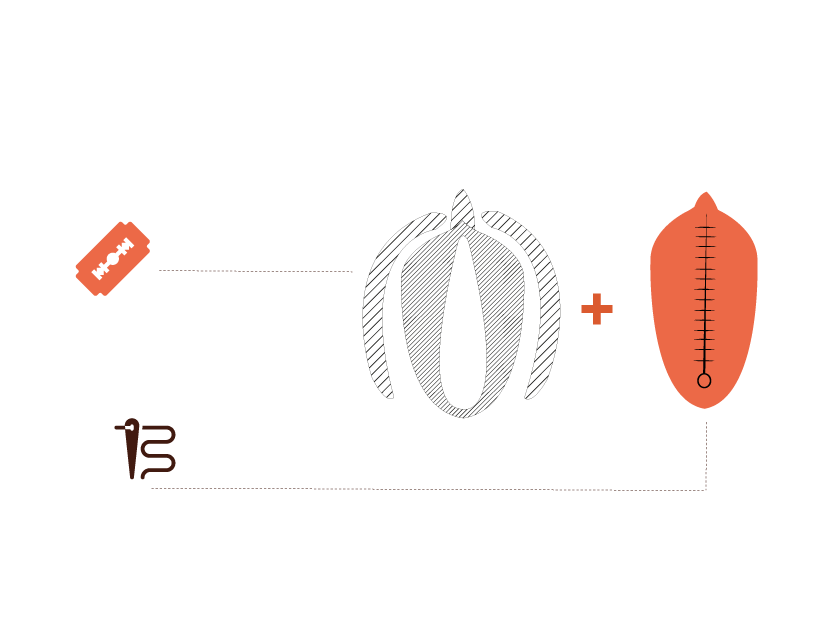GAMS BELGIUM
What is FGM?
We recognize female genital mutilation as a form of gender-based violence.
Definition of Gender-Based Violence:
Gender-based violence refers to violence perpetrated against an individual based on their gender, rooted in societal expectations of gender roles.
These forms of violence can have significant consequences for the victims and can affect various aspects of their lives (personal, professional, etc.).
FGM
Female genital mutilation, also known as female genital cutting or female circumcision, involves intentional alteration or injury to the external female genitalia for non-medical reasons. The World Health Organization (WHO) categorizes FGM into four main types:
Type I · Clitoridectomy
Partial or total removal of the clitoral glans and/or the prepuce.

Type II · Excision
Partial or total removal of the clitoral glans and the labia minora, with or without excision of the labia majora

Type III · Infibulation
Narrowing of the vaginal opening through the creation of a covering seal, achieved by cutting and repositioning the labia minora and/or labia majora, with or without removal of the clitoral glans.

Type IV
All other harmful procedures to the female genitalia for non-medical purposes, such as pricking, piercing, incising, scraping, and cauterizing the genital area
Remarks
- In practice, they are often distinguished into two main categories: excision and infibulation (the distinction between types 1 and 2 is not always easy for a clinician who is not familiar with female genital mutilation). It also happens that the labia minora fuse spontaneously without any suturing with thread or acacia thorns.
- The clitoris is a large organ (8 to 10 cm) with the majority of it being internal. Excision involves the removal of the visible or external part (the clitoral glans) but not the entire clitoris. The World Health Organization (WHO) updated the description of different types of FGM in 2022, replacing “total removal of the clitoris” with “total removal of the clitoral glans.”
Other practices related to FGM
In the worlD
The most recent estimates (UNICEF 2020) suggest that 230 million girls and women have undergone female genital mutilation (FGM), and 4 million girls are at risk each year.
Half of the affected population, totaling 100 million, is concentrated in three countries: Egypt, Ethiopia, and Indonesia. While the practice is prevalent in at least 28 African countries, it is also found in Asia (Indonesia, Malaysia), the Arabian Peninsula (Yemen, Oman), the Middle East (Iraq, Iran), and Latin America (Colombia, Peru).
Prevalence varies significantly between regions, including within countries. Ethnic group and region of origin are determining factors.
Prevalence in % : 15-49 years
Sources based on DHS & MICS (April 2022) & other nationally representative surveys

South Africa
cases reported among migrant populations
Alaska (USA)
cases reported among migrant populations
Australia
cases reported among migrant populations
Benin
9,2% of women
Bangladesh
cases limited to certain communities
Burkina Faso
74,8% of women
Canada
cases reported among migrant populations
Cameroon
1,4% of women
Colombia
cases limited to certain communities
Ivory Coast
36,7% of women
Djibouti
93,1% of women
Egypt
87,2% of women
Eritrea
83% of women
Ethiopia
65,2% of women
Europe
cases reported among migrant populations
Gabon
cases reported among migrant populations
Gambie
72,6% de femmes
Ghana
2,4% of women
Guinea
94,5% of women
Guinea-Bissau
52,1% of women
Equatorial Guinea
cases limited to certain communities
Indonesia
51,2% of women
India
cases limited to certain communities
Irak
7,4% of women
Iran
cases limited to certain communities
Palestine
cases limited to certain communities
Jordania
cases limited to certain communities
Kenya
21% of women
Liberia
31,8% of women
Lybia
cases reported among migrant populations
Lybie
cas rapportés parmi les populations migrantes
Nigeria
19,5% of women
Niger
2% of women
Maldives
12,9% of women
Mali
88,6% of women
Malaisia
cases limited to certain communities
Mauritania
66,6% of women
Mexico
cases reported among migrant populations
Ouganda
0,3% of women
Oman
cases limited to certain communities
Pakistan
cases limited to certain communities
Peru
cases limited to certain communities
Philippines
cases limited to certain communities
République Cantrafricaine
21,6% of women
Democratic Republic of Congo
cases limited to certain communities
Senegal
25,2% of women
Sierra Leone
83% of women
Somalia
99,2% of women
Soudan
86,6% of women
Sri Lanka
cases limited to certain communities
Syria
cases reported among migrant populations
Tanzania
10% of women
Thaïland
cases limited to certain communities
Tchad
34,1% des femmes
Togo
3,1% of women
Yemen
18,5% of women
Turkiye
cases reported among migrant populations
USA
cases reported among migrant populations
Zimbabwe
cases limited to certain communities
Download our poster
Our “Prevalence of female genital mutilation in the world” posters are available in 2 languages.
Reasons cited
Several reasons are cited by affected populations to justify these practices, and many combinations are possible. The reasons typically cited vary depending on the country and ethnicity, but also within the same ethnic group. (Gillette-Frenoy 1992).
Respect for custom or tradition
This is the most common response to the question: why excise? It’s because it has always been done, it is done, that’s it. It’s natural, it’s normal.
Social cohesion, social integration
to be like everyone else, not to be excluded.
Marriage
An unexcised girl will not find a husband. This is one of the most cited reasons, in line with respect for tradition. Some girls are re-excised before marriage if it is noticed that it was not done properly, or in the case of infibulations, if the scar has spontaneously separated. Some mothers acknowledge the dangers of FGM, but admit that being unable to marry in their society is worse than the risk of complications from FGM, and therefore consider it the best choice they can make for their daughters.
Virginity, chastity, fidelity
FGM is seen as a means to preserve the honor of the family by preventing any sexual desire and pregnancy before marriage.
In the context of polygamous marriages, where the husband may not be able to satisfy all his wives and where the woman might be frustrated and tempted to have an extramarital relationship, FGM is seen as a way to preserve the honor of the husband.
Fertility
There are many myths surrounding fertility. These practices are believed to increase fertility and promote child survival.
For example, some communities believe that if the clitoris is not cut, it will grow to the size of the penis, or that the clitoris is a dangerous organ that could harm the man during penetration (and render him impotent or sterile) or hinder the smooth progress of childbirth.
Seduction, beauty
Particularly in ethnic groups that practice infibulation, an open, gaping sex organ is considered unattractive. A sewn, closed, hairless sex organ is perceived as more hygienic and is believed to make the woman more attractive.
Purity, cleanliness
As long as a girl has not been circumcised or infibulated, she will be considered impure, dirty, and certain tasks, such as preparing meals or serving food, will be forbidden to her.
Religion
The practice of FGM predates the advent of monotheistic religions, particularly Islam. While neither the Quran nor any other religious text prescribes excision or infibulation, some communities practice it believing it is required by religion.
Note that FGM persists among Christian communities (Catholics, Protestants, Copts), Jewish communities in Ethiopia (the Falashas), and animists. Various religious authorities differ in opinion: some encourage it, others consider it alien to the religion, and still others advocate for its abolition.
Regarding Islam, at an international meeting at al-Azhar University in Cairo in 2006, senior Sunni representatives spoke out against FGM (issuing a fatwa declaring that FGM is unfounded in Islamic law) (Andro & Lesclingand 2007).
Type 1 FGM is often referred to as Sunna by Muslim communities. Sunna represents in Islam everything that is good for God, and using this term to refer to clitoridectomy contributes to the confusion and the idea that FGM is a prescription of Islam.
While the status of excisers may not be among the justifications cited by the population, it can nonetheless be considered a factor favoring the continuation of these practices. Indeed, female genital mutilation (FGM) serves as a source of income and social recognition for excisers.
Consequently, they have no interest in discontinuing the practice. Additionally, this role may also be inherited. A daughter of an exciser may be compelled to become one herself without having a choice.
WHO PRACTICES FGM
& AT WHAT AGE?
In countries of origin, mutilations are typically performed by elderly women, traditional birth attendants, or barbers, and sometimes by doctors or midwives in a medical setting, although this is prohibited by the WHO.
In Western countries that host communities from these countries, young girls are still victims. Families may call upon an expatriate exciser or send their daughters back to their home country for the procedure.
Mutilations are generally performed between the ages of 4 and 14, but they can also be done at a few months old or just before marriage. In recent years, there has been a lowering of the age of excision. One reason is to hide the practice from authorities as many countries have legislated against it. The child is then too young to escape or lodge a complaint.
What are the consequences ?
Immediate complications
- Intense pain, accompanied by fear and anxiety that can lead to shock
- Bleeding that may lead to death
- Wound infections
- Urinary retention
- Injuries to nearby organs
Psychological consequences
Female genital mutilation can leave a lifelong mark on a woman
The traumatic nature of the event may be repressed in the subconscious at the time of the mutilation and resurface years later, manifesting in various ways.
- Loss of trust in loved ones (feeling betrayed by parents)
- Behavioral issues
- Anxiety, distress (flashbacks, nightmares)
- Depression – PTSD (Post-Traumatic Stress Disorder)
Long-term complications
- Urinary and genital infections, urinary stones, neuromas.
- Difficulty urinating, pain during menstruation, incontinence.
- Pain at the scar site, cysts, abscesses.
- Issues related to pregnancy and childbirth (blocked labor, tears, fistulas).
- Sexual dysfunction (for both partners).
- Risk of HIV transmission.
- Infections of the fallopian tubes, infertility.
Long-term complications vary depending on the type of excision and the aftermath of the procedure (infection, anemia, healing issues, etc.). Type III excisions are the ones most associated with infections and childbirth problems due to infibulation. Dyspareunia (pain during sexual intercourse) may occur if the scar is painful or if a neuroma develops.
